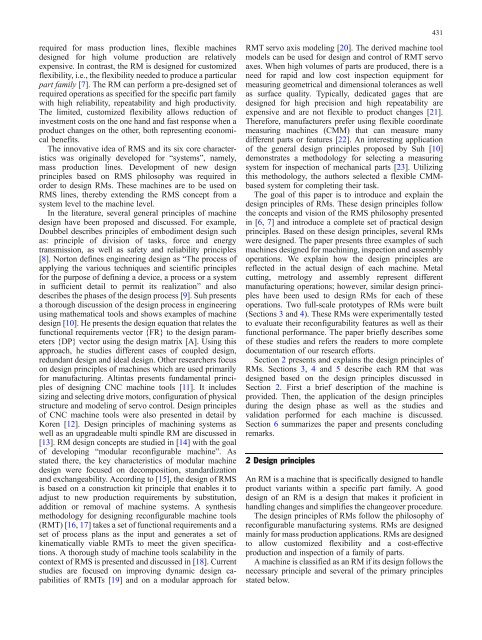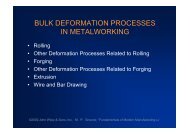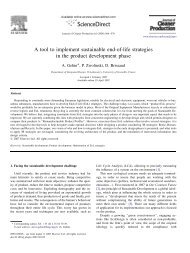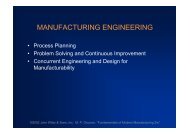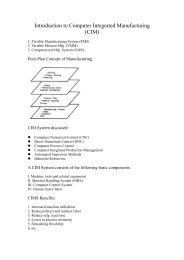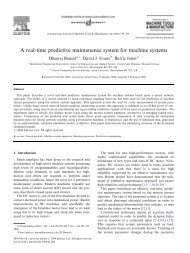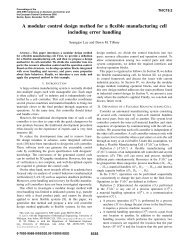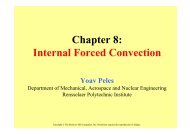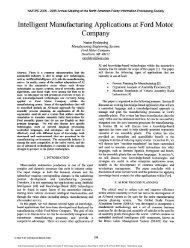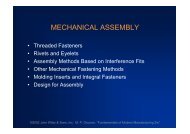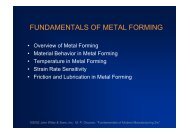Design principles of reconfigurable machines
Design principles of reconfigurable machines
Design principles of reconfigurable machines
You also want an ePaper? Increase the reach of your titles
YUMPU automatically turns print PDFs into web optimized ePapers that Google loves.
431required for mass production lines, flexible <strong>machines</strong>designed for high volume production are relativelyexpensive. In contrast, the RM is designed for customizedflexibility, i.e., the flexibility needed to produce a particularpart family [7]. The RM can perform a pre-designed set <strong>of</strong>required operations as specified for the specific part familywith high reliability, repeatability and high productivity.The limited, customized flexibility allows reduction <strong>of</strong>investment costs on the one hand and fast response when aproduct changes on the other, both representing economicalbenefits.The innovative idea <strong>of</strong> RMS and its six core characteristicswas originally developed for “systems”, namely,mass production lines. Development <strong>of</strong> new design<strong>principles</strong> based on RMS philosophy was required inorder to design RMs. These <strong>machines</strong> are to be used onRMS lines, thereby extending the RMS concept from asystem level to the machine level.In the literature, several general <strong>principles</strong> <strong>of</strong> machinedesign have been proposed and discussed. For example,Doubbel describes <strong>principles</strong> <strong>of</strong> embodiment design suchas: principle <strong>of</strong> division <strong>of</strong> tasks, force and energytransmission, as well as safety and reliability <strong>principles</strong>[8]. Norton defines engineering design as “The process <strong>of</strong>applying the various techniques and scientific <strong>principles</strong>for the purpose <strong>of</strong> defining a device, a process or a systemin sufficient detail to permit its realization” and alsodescribes the phases <strong>of</strong> the design process [9]. Suh presentsa thorough discussion <strong>of</strong> the design process in engineeringusing mathematical tools and shows examples <strong>of</strong> machinedesign [10]. He presents the design equation that relates thefunctional requirements vector {FR} to the design parameters{DP} vector using the design matrix [A]. Using thisapproach, he studies different cases <strong>of</strong> coupled design,redundant design and ideal design. Other researchers focuson design <strong>principles</strong> <strong>of</strong> <strong>machines</strong> which are used primarilyfor manufacturing. Altintas presents fundamental <strong>principles</strong><strong>of</strong> designing CNC machine tools [11]. It includessizing and selecting drive motors, configuration <strong>of</strong> physicalstructure and modeling <strong>of</strong> servo control. <strong>Design</strong> <strong>principles</strong><strong>of</strong> CNC machine tools were also presented in detail byKoren [12]. <strong>Design</strong> <strong>principles</strong> <strong>of</strong> machining systems aswell as an upgradeable multi spindle RM are discussed in[13]. RM design concepts are studied in [14] with the goal<strong>of</strong> developing “modular <strong>reconfigurable</strong> machine”. Asstated there, the key characteristics <strong>of</strong> modular machinedesign were focused on decomposition, standardizationand exchangeability. According to [15], the design <strong>of</strong> RMSis based on a construction kit principle that enables it toadjust to new production requirements by substitution,addition or removal <strong>of</strong> machine systems. A synthesismethodology for designing <strong>reconfigurable</strong> machine tools(RMT) [16, 17] takes a set <strong>of</strong> functional requirements and aset <strong>of</strong> process plans as the input and generates a set <strong>of</strong>kinematically viable RMTs to meet the given specifications.A thorough study <strong>of</strong> machine tools scalability in thecontext <strong>of</strong> RMS is presented and discussed in [18]. Currentstudies are focused on improving dynamic design capabilities<strong>of</strong> RMTs [19] and on a modular approach forRMT servo axis modeling [20]. The derived machine toolmodels can be used for design and control <strong>of</strong> RMT servoaxes. When high volumes <strong>of</strong> parts are produced, there is aneed for rapid and low cost inspection equipment formeasuring geometrical and dimensional tolerances as wellas surface quality. Typically, dedicated gages that aredesigned for high precision and high repeatability areexpensive and are not flexible to product changes [21].Therefore, manufacturers prefer using flexible coordinatemeasuring <strong>machines</strong> (CMM) that can measure manydifferent parts or features [22]. An interesting application<strong>of</strong> the general design <strong>principles</strong> proposed by Suh [10]demonstrates a methodology for selecting a measuringsystem for inspection <strong>of</strong> mechanical parts [23]. Utilizingthis methodology, the authors selected a flexible CMMbasedsystem for completing their task.The goal <strong>of</strong> this paper is to introduce and explain thedesign <strong>principles</strong> <strong>of</strong> RMs. These design <strong>principles</strong> followthe concepts and vision <strong>of</strong> the RMS philosophy presentedin [6, 7] and introduce a complete set <strong>of</strong> practical design<strong>principles</strong>. Based on these design <strong>principles</strong>, several RMswere designed. The paper presents three examples <strong>of</strong> such<strong>machines</strong> designed for machining, inspection and assemblyoperations. We explain how the design <strong>principles</strong> arereflected in the actual design <strong>of</strong> each machine. Metalcutting, metrology and assembly represent differentmanufacturing operations; however, similar design <strong>principles</strong>have been used to design RMs for each <strong>of</strong> theseoperations. Two full-scale prototypes <strong>of</strong> RMs were built(Sections 3 and 4). These RMs were experimentally testedto evaluate their reconfigurability features as well as theirfunctional performance. The paper briefly describes some<strong>of</strong> these studies and refers the readers to more completedocumentation <strong>of</strong> our research efforts.Section 2 presents and explains the design <strong>principles</strong> <strong>of</strong>RMs. Sections 3, 4 and 5 describe each RM that wasdesigned based on the design <strong>principles</strong> discussed inSection 2. First a brief description <strong>of</strong> the machine isprovided. Then, the application <strong>of</strong> the design <strong>principles</strong>during the design phase as well as the studies andvalidation performed for each machine is discussed.Section 6 summarizes the paper and presents concludingremarks.2 <strong>Design</strong> <strong>principles</strong>An RM is a machine that is specifically designed to handleproduct variants within a specific part family. A gooddesign <strong>of</strong> an RM is a design that makes it pr<strong>of</strong>icient inhandling changes and simplifies the changeover procedure.The design <strong>principles</strong> <strong>of</strong> RMs follow the philosophy <strong>of</strong><strong>reconfigurable</strong> manufacturing systems. RMs are designedmainly for mass production applications. RMs are designedto allow customized flexibility and a cost-effectiveproduction and inspection <strong>of</strong> a family <strong>of</strong> parts.A machine is classified as an RM if its design follows thenecessary principle and several <strong>of</strong> the primary <strong>principles</strong>stated below.


